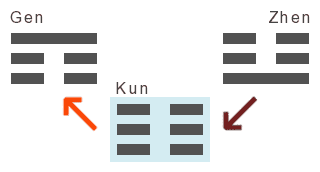What does Kun represent?
To describe Kun, one could choose the following image: cultivated soil in which a seedling is growing. In this image, cultivated soil represents unstructured matter; the seedling finds necessary for its growth in the soil, and dead plant parts decompose back into the soil.
However, Kun transcends the concept of unstructured matter embodied by cultivated soil: Kun represents unstructured potential itself, encompassing both material and non-material possibilities. Therefore, Kun represents an unstructured wellspring of power that we can connect with, just as if we were a wave receding deep into the ocean, returning to its origin to concentrate and to gather new strength.
Becoming Calm and Sensing the Impulses from Within Ourselves…
…and then, when we are fully recharged and brimming with energy, allowing the impulses emerge from within. Impulses which we only can perceive when we have become completely calm and arrived within ourselves.
These inner impulses resemble the growth impulse of a seedling. Even as an ungerminated seed, it already carries the image of the fully grown plant within itself. Carrying such an image within oneself means that t the seed’s germination is not a blind process. Instead, it follows a predetermined path, a path that unfolds and adapts to the surrounding conditions, step by step, day by day, year after year.
We, too, carry such an image within us. Unfortunately, amidst the chaos of everyday life, it often gets obscured That is why maintaining contact with our inner image and the impulses from within us is crucial. They provide us with guidance and illuminate the path towards our goals.
According to King Wen’s Later Heaven, Kun is associated with the functional circuits Stomach and Spleen (SP). The analogy to Kun‘s unstructured potential becomes evident when considering that our digestive processes follow principles similar to the transformation processes in cultivated soil.
The corresponding quotes from the classics of Traditional Chinese Medicine can be found here: Phase Element Earth: Stomach and Spleen-Pancreas
Following the Path of the Dao: Sensing and Trusting
Kun is one of the quiet points in the model Follow the path of the Dao. Ideally, we have now fully centered ourselves and discovered inner peace. And we have integrated both conscious and (formerly) repressed parts to the best of our ability, enabling us to draw upon them now.
When it comes to self-exploration, Kun is about our relationship with ourselves and the process of self-encounter. This includes both sensing and exploring who we truly (!) are and placing trust in the natural flow of life.
Questions that could be asked in this context include:
- How am I doing? How do I feel about myself?
- Am I standing by myself? Can I accept and engage with myself as I am?
- Am I at peace with myself? Can I embrace the parts of myself that, superficially speaking, may seem less appealing?
- What do I expect when I choose to do nothing – when I refrain from controlling, initiating, or interfering, and simply allow things to unfold? How do I feel when I contemplate that? Do I feel safe, with the belief that everything will work out fine? Or do I sense potential danger in my inaction?
What does Kun emerge from?
Regarding the changes within a hexagram Kun is an exception insofar as it can only emerge from one trigram: Zhen. When a (broken) yin line is added to Zhen, Kun emerges. (dark arrow; yin represents receptiveness).
Kun emerges from Zhen, the Thunder
Zhen, the thunder, symbolizes the germinal seed of a new action, the first step towards a new direction. When Kun follows as the subsequent trigram, this impulse encounters unstructured potential: fertile ground from which anything can grow.
Examples of hexagrams where Kun emerges from Zhen can be found → here.
What does Kun develop into?
Again Kun is an exception: Kun can only develop into one trigram. Gen emerges when a (solid) Yang line is added on top (red arrow; Yang symbolizes energy, activity).
Kun develops into Gen, the Mountain
Through acceptance and allowing things to happen (Kun), the unstructured potential has manifested into something concrete. During this process, we may become aware of things that represent unnecessary baggage and hinder our progress. When Gen, the mountain, emerges from Kun, we can confidently let go of this excess baggage and allow the force of the Earth‘s gravity to take effect. In doing so, we liberate not only our muscles and tendons but our entire being.
Examples of hexagrams where Kun develops into Gen can be found → here.
References
Phase Element: Earth
Functional Circuit: Stomach (St) / Spleen (SP)
Modern Interpretation
Accepting that what is here and now; peace, stability, resting within oneself, feeling supported and maintained; to make good use of things; relationship and commitment; self-esteem; compassion
Traditional Interpretation
Receptive, devoted, open, ductile, dark, nurturing, soft, flexible, adaptive, accepting the given, fertile
Direction: downwards
Interpretation: The highest principle of matter; an unstructured, wide field for action





